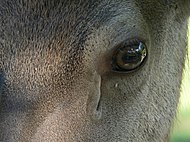Preorbital gland
| Preorbital gland | |
|---|---|
 |
|

|
|
| Details | |
| Artery | lacrimal artery |
| Nerve | lacrimal nerve, Zygomatic nerve via Communicating branch, greater petrosal nerve |
| Identifiers | |
| Latin | glandula praeorbitalis |
| MeSH | Apparatus D007765 |
| Dorlands /Elsevier |
g_06/12392431 |
|
Anatomical terminology
[]
|
|
The preorbital gland is a paired exocrine gland found in many species of hoofed animals, which is homologous to the lacrimal gland found in humans. These glands are trenchlike slits of dark blue to black, nearly bare skin extending from the medial canthus of each eye. They are lined by a combination of sebaceous and sudoriferous glands, and they produce secretions which contain pheromones and other semiochemical compounds. Ungulates frequently deposit these secretions on twigs and grass as a means of communication with other animals.
The preorbital gland serves different roles in different species. Pheromone-containing secretions from the preorbital gland may serve to establish an animal's dominance (especially in preparation for breeding), mark its territory, or simply to produce a pleasurable sensation to the animal. Because of its critical role in scent marking, the preorbital gland is usually considered as a type of scent gland. A further function of these glands may be to produce antimicrobial compounds to fight against skin pathogens. Antimicrobial compounds found in these glands may be biosynthesized by the animal itself, or by microorganisms that live in these glands.
Deer have seven major external scent glands, distributed throughout their bodies. These glands are the forehead glands (located on the forehead), the preorbital glands (located below the eyes), the nasal glands (located inside the nostrils), the interdigital glands (located between the toes), the preputial gland (located inside the foreskin of the deer's penis), the metatarsal glands (located outside of the hind legs), and the tarsal glands (located inside of the hind legs). Though it is not their primary function, the salivary glands also function as scent glands. Deer rely heavily on these scent glands to communicate with other members of their species, and possibly even with members of other species. A deer may rub its preorbital gland (e.g., on a branch) purely for pleasure.
...
Wikipedia
